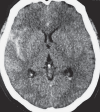Early endovascular treatment of aneurysmal subarachnoid hemorrhage complicated by neurogenic pulmonary edema and Takotsubo-like cardiomyopathy
- PMID: 24976204
- PMCID: PMC4202891
- DOI: 10.15274/NRJ-2014-10035
Early endovascular treatment of aneurysmal subarachnoid hemorrhage complicated by neurogenic pulmonary edema and Takotsubo-like cardiomyopathy
Abstract
Aneurysmal subarachnoid hemorrhage (SAH) may be associated with acute cardiopulmonary complications, like neurogenic pulmonary edema (NPE) and Takotsubo-like cardiomyopathy (TCM). These dysfunctions seem to result from a neurogenically induced overstimulation of the sympathetic nervous system through the brain-heart connection and often complicate poor grade aneurysmal SAH. The optimal treatment modality and timing of intervention in this clinical setting have not been established yet. Early endovascular therapy seems to be the fitting treatment in this particular group of patients, in which surgical clipping is often contraindicated due to the added risk of craniotomy. Herein we describe the case of a woman admitted to the emergency department with aneurysmal SAH complicated by NPE-TCM, in which early endovascular coiling was successfully performed. Our case, characterized by a favorable outcome, further supports the evidence that early endovascular treatment should be preferred in this peculiar clinical scenario.
Keywords: Takotsubo cardiomyopathy; aneurysmal subarachnoid hemorrhage; endovascular treatment; neurogenic pulmonary edema.
Figures





Similar articles
-
Neurogenic pulmonary edema and Takotsubo cardiomyopathy in aneurysmal subarachnoid hemorrhage.Acta Neurochir (Wien). 2023 Dec;165(12):3677-3684. doi: 10.1007/s00701-023-05824-y. Epub 2023 Nov 4. Acta Neurochir (Wien). 2023. PMID: 37924360
-
Subarachnoid hemorrhage complicated with neurogenic pulmonary edema and takotsubo-like cardiomyopathy.Neurol Med Chir (Tokyo). 2012;52(2):49-55. doi: 10.2176/nmc.52.49. Neurol Med Chir (Tokyo). 2012. PMID: 22362283
-
Neurogenic stress cardiomyopathy following aneurysmal subarachnoid hemorrhage in a very elderly patient--case report.Neurol Med Chir (Tokyo). 2011;51(12):842-6. doi: 10.2176/nmc.51.842. Neurol Med Chir (Tokyo). 2011. PMID: 22198107
-
Neurogenic Stunned Myocardium: A Review.AACN Adv Crit Care. 2021 Sep 15;32(3):275-282. doi: 10.4037/aacnacc22021250. AACN Adv Crit Care. 2021. PMID: 34490446 Review.
-
Perioperative Management of Aneurysmal Subarachnoid Hemorrhage.Anesthesiology. 2020 Dec 1;133(6):1283-1305. doi: 10.1097/ALN.0000000000003558. Anesthesiology. 2020. PMID: 32986813 Review.
Cited by
-
Endovascular Therapy for Aneurysmal Subarachnoid Hemorrhage Complicated by Neurogenic Pulmonary Edema and Takotsubo-Like Cardiomyopathy: A Report of Ten Cases.Asian J Neurosurg. 2020 Feb 25;15(1):113-119. doi: 10.4103/ajns.AJNS_331_19. eCollection 2020 Jan-Mar. Asian J Neurosurg. 2020. PMID: 32181183 Free PMC article.
-
Successful Coil Embolization Using Percutaneous Cardiopulmonary Support in a Patient with Refractory Out-of-hospital Cardiac Arrest Caused by Aneurysmal Subarachnoid Hemorrhage.NMC Case Rep J. 2021 Jul 9;8(1):393-398. doi: 10.2176/nmccrj.cr.2020-0379. eCollection 2021. NMC Case Rep J. 2021. PMID: 35079494 Free PMC article.
-
Diagnosis and Management of Takotsubo Syndrome in Acute Aneurysmal Subarachnoid Hemorrhage: A Comprehensive Review.Rev Cardiovasc Med. 2023 Jun 19;24(6):177. doi: 10.31083/j.rcm2406177. eCollection 2023 Jun. Rev Cardiovasc Med. 2023. PMID: 39077518 Free PMC article. Review.
-
Neurogenic pulmonary edema and Takotsubo cardiomyopathy in aneurysmal subarachnoid hemorrhage.Acta Neurochir (Wien). 2023 Dec;165(12):3677-3684. doi: 10.1007/s00701-023-05824-y. Epub 2023 Nov 4. Acta Neurochir (Wien). 2023. PMID: 37924360
-
Distant Organ Damage in Acute Brain Injury.Brain Sci. 2020 Dec 21;10(12):1019. doi: 10.3390/brainsci10121019. Brain Sci. 2020. PMID: 33371363 Free PMC article. Review.
References
-
- Mayer SA, Lin J, Homma S, et al. Myocardial injury and left ventricular performance after subarachnoid hemorrhage. Stroke. 1999;30(4):780–786. doi: 10.1161/01.STR.30.4.780. - DOI - PubMed
-
- Inamasu J, Nakatsukasa M, Mayanagi K, et al. Subarachnoid hemorrhage complicated with neurogenic pulmonary edema and Takotsubo-like cardiomyopathy. Neurol Med Chir (Tokyo) 2012;52(2):49–55. doi: 10.2176/nmc.52.49. - DOI - PubMed
-
- Ako J, Honda Y, Fitzgerald PJ. Tako-tsubo-like left ventricular dysfunction. Circulation. 2003;108(23):e158. doi: 10.1161/01.CIR.0000102942.24174.AE. - DOI - PubMed
-
- Abe Y, Kondo M. Apical ballooning of the left ventricle: a distinct entity? Heart. 2003;89(9):974–976. doi: 10.1136/heart.89.9.974. - DOI - PMC - PubMed
-
- Lee VH, Oh JK, Mulvagh SL, et al. Mechanism in neurogenic stress cardiomyopathy after aneurysmal subarachnoid hemorrhage. Neurocrit Care. 2006;5(3):243–249. doi: 10.1385/NCC:5:3:243. - DOI - PubMed
Publication types
MeSH terms
LinkOut - more resources
Full Text Sources
Other Literature Sources

